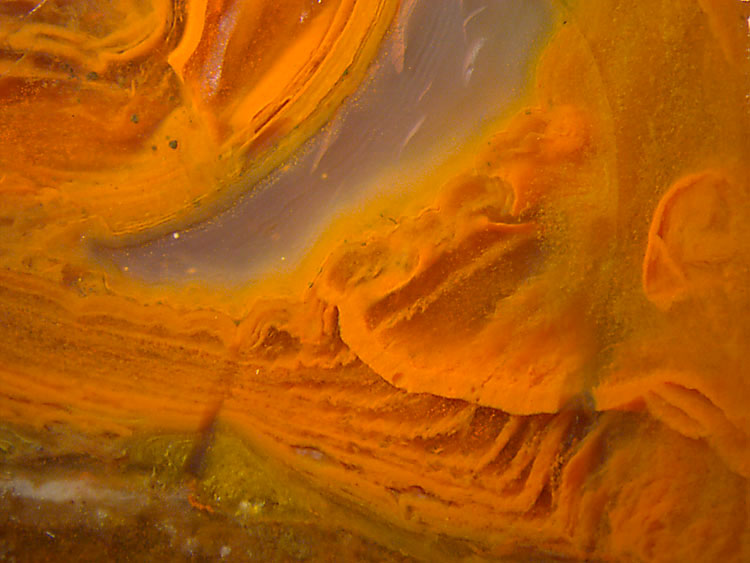Eerie shapes athwart microbial layer
stacks -
(3)
 A
certain type of silicification phenomena in cherts from the Döhlen
basin have been called "eerie shapes" for their puzzling appearance: Permian
Chert News 18
and 27
. In view of the present
lack of a reasonable explanation it
is hoped that more pictures will lead the way to
understanding.
A
certain type of silicification phenomena in cherts from the Döhlen
basin have been called "eerie shapes" for their puzzling appearance: Permian
Chert News 18
and 27
. In view of the present
lack of a reasonable explanation it
is hoped that more pictures will lead the way to
understanding.
Fig.1: Stack of microbial sheets
stained with hematite
deposited as
a result of oxygen production of blue-green algae as known from the
"banded iron formation",
much later superposed by hematite of unknown origin and in enigmatic
shapes. Image width 3.5mm.
From the obvious fact that the red shapes in Fig.1 are not affeced by
the layered structure of
the stack of microbial sheets
it can be concluded that they formed much later when the stack had become
rather homogeneous by thorough silicification. Likewise it is obvious that the big
enigmatic shapes did not at all interfere with the delicate
sheets.
The red shapes must have emerged at a late stage of
chert formation, judging from traversed brittle cracks.
Some of the
enigmatic shapes may mislead the observer into the assumption that they
had been cracks: The branching shape in Fig.1 looks like wide
cracks in gel but this impression is immediately dispelled by the
shapes seen above. 
Occasionally
the enigmatic red shapes are seen as closed loops on the cut planes
which possibly indicates that they are really closed bags, like the
small
one in
Fig.1 and the big one in Fig.2. The red circle in Fig.2 seems to be a
different enigma, not found anywhere else.
Fig.2: Stack of microbial sheets apparently enclosed in a red bag;
tree fern
root wall tissue (above) superposed by an enigmatic red
circle.
Image
width 3.5mm.
Fig.3 (below): Microbial layer stacks, bent and
deformed by lateral compression, superposed by enigmatic shapes with
bulging bags and cut-off ends unrelated to the underlying structure.
Image
width 4.3mm, same scale as above.

A bag-like structure is also seen in Fig.3 at either end of the enigmatic
red shape: a bulging one on the left and a narrow one on the right. The layers
or sheets of
stained microbes are not horizontal here because the stack had been
deformed by lateral compression
so that it became bent upward and
the individual sheets
became wavy. The 3D-aspect offered by the clear chalcedony reveals
another enigma: a wide gap in the red shape (below right). There is no
indication that this gap has been brought about by a crack. It seems to
be only a strip without stain, extending into the depth.
Still more enigmatic is the sudden end of the bright red streak
above left.
It appears that also Part 3 of this series, instead of contributing to understanding, offers additional enigmatic features of the
shapes that seem to be not related to underlying structures: closed
bags in Figs.1-3, a circle in Fig.2, and cut-off ends in Fig.3.
Sample: H/375.1,
old
fragment (12kg)
of a Lower Permian chert layer, found in 1999
among glacial river
deposits at Hänichen,
Döhlen basin, Freital near Dresden, Saxony.
H.-J.
Weiss 2020
|
 |
 28 28 |

 28
28 A
certain type of silicification phenomena in cherts from the Döhlen
basin have been called "eerie shapes" for their puzzling appearance: Permian
Chert News 18
and 27
. In view of the present
lack of a reasonable explanation it
is hoped that more pictures will lead the way to
understanding.
A
certain type of silicification phenomena in cherts from the Döhlen
basin have been called "eerie shapes" for their puzzling appearance: Permian
Chert News 18
and 27
. In view of the present
lack of a reasonable explanation it
is hoped that more pictures will lead the way to
understanding. 


 28
28